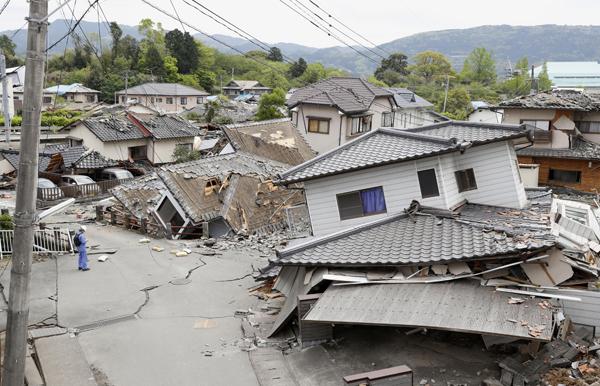You are here
Second deadly quake hits Japan, ‘race against time’ to find survivors
By Reuters - Apr 16,2016 - Last updated at Apr 16,2016

Damaged houses sit after an earthquake in Mashiki, Kumamoto prefecture, southern Japan, on Saturday (AP photo/Kyodo News)
TOKYO — Japanese rescuers were digging through the rubble of buildings and mud on Saturday to reach dozens believed trapped after a powerful 7.3 magnitude earthquake struck a southern island, killing at least 32 people and injuring about a thousand.
The shallow earthquake hit in the early hours, sending people fleeing from their beds on to dark streets, and followed a 6.4 magnitude quake on Thursday which killed nine people in the area. Rain and cold were forecast overnight, adding extra urgency to the rescue effort.
Television footage showed fires, power outages, collapsed bridges, a severed road hanging over a ravine and gaping holes in the earth. Residents near a dam were told to leave because of fears it might crumble, broadcaster NHK said.
"I felt strong shaking at first, then I was thrown about like I was in a washing machine," said a Tokai University student who remains isolated in the village of Minamiaso in Kumamoto province on the island of Kyushu.
"All the lights went out and I heard a loud noise. A lot of gas is leaking and while there hasn't been a fire, that remains a concern," the student, who is sheltering in a university gym with 1,000 other students and residents, told Japanese media.
Many frightened people wrapped in blankets sat outside their homes while others camped out in rice fields in rural areas surrounding the main towns. About 422,000 households were without water and about 100,000 without electricity, the government said. Troops were setting up tents for evacuees and water trucks were being sent to the area.
The national police agency said 32 people were confirmed dead. The government said about 190 of those injured were in serious condition.
Heavy rain and wind were forecast, with temperature expected to drop to 13°C overnight. Firefighters handed out tarpaulins to residents so they could cover damaged roofs.
"The wind is expected to pick up and rain will likely get heavier," Prime Minister Shinzo Abe told a government meeting. "Rescue operations at night will be extremely difficult ... It's a race against time."
Self-defence forces personnel in the town of Mashiki, close to the epicentre, were providing food and water.
"I don't mind standing in line. I'm just thankful for some food," said a man in his 60s waiting for a meal.
Japan is on the seismically active "ring of fire" around the Pacific Ocean and has building codes aimed at helping structures withstand earthquakes.
A magnitude 9 quake in March 2011 north of Tokyo touched off a massive tsunami and nuclear meltdowns at Fukushima, contaminating water, food and air for kilometres around. Nearly 20,000 people were killed in the tsunami.
The epicentre of Saturday's quake was near the city of Kumamoto and measured at a shallow depth of 10 km (six miles), the United States Geological Survey (USGS) said. The shallower a quake, the more likely it is to cause damage.
The quake triggered a tsunami advisory which was later lifted and no irregularities were reported at three nuclear power plants in the area, a senior government official said.
Tsunami alert lifted
The city's 400-year-old Kumamoto Castle was badly damaged, with its walls breached after having withstood bombardment and fire in its four centuries of existence.
Bank of Japan Governor Haruhiko Kuroda, speaking at a G20 event in Washington, said it was too early to assess the economic impact but bank operations in Kumamoto were normal.
The USGS, which is a government scientific body, estimated that there was a 72 per cent likelihood of economic damage exceeding $10 billion, adding that it was too early to be specific. Major insurers are yet to release estimates.
Electronics giant Sony Corp said a factory producing image sensors for smartphone makers would remain closed while it assessed the damage from the quakes. One of its major customers is Apple which uses the sensors in iPhones.
Toyota Motor Corp. halted production at three plants producing vehicles, engines and trans axles in Fukuoka. Toyota said there was no damage at its plants, but it was checking the status of its suppliers. It will decide on Sunday whether to resume production.
Nissan Motor Co. Ltd. stopped production at its Fukuoka plant which produces vehicles including the Serena, Teana, Murano and Note.
South Korea said it had rented five buses to transport 200 South Korean tourists stranded in Oita, to the east of Kumamoto.
Chief Cabinet Secretary Yoshihide Suga said nearly 80 people were believed trapped or buried in rubble. Rescuers managed to pull 10 students out of a collapsed university apartment in the town of Minami on Saturday.
Related Articles
JAKARTA — A 6.7 magnitude earthquake struck Indonesia’s Banda Sea on Wednesday, the United States Geological Survey said, hours after a stro
RABAT — A strong 6.1-magnitude earthquake struck early Monday in the Mediterranean between Morocco and Spain, the US Geological Survey said.
BEIRUT — Iran's southeastern province of Kerman was hit by multiple strong quakes on Tuesday and Wednesday, injuring at least 18 people and
















